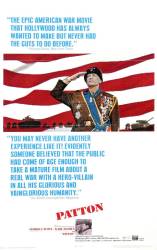Factual error: When Patton orders his driver to drive to the Carthaginian battlefield he addresses him as "sergeant". He is, however, wearing corporal's chevrons. A famous stickler for discipline and ceremonial, Patton is not likely to have made a mistake like this.
Factual error: In one scene of the film, Rommel is shown wearing a swastika pin. Rommel was not a member of the Nazi party and refused to wear any Nazi insignia (outside of uniform symbols which contained it), instead he wore the traditional Prussian Iron Cross.
Revealing mistake: Several maps of Europe shown in the film have Germany divided into East and West, and show national borders from 1945 onwards.
Factual error: The British drum major in the Messina parade gives the order "Forward March". This is only used by the British forces when troops are marking time. If at the halt, as here, the order is "Quick March".
Continuity mistake: In the scene before Patton hears the news of getting relieved of command, he is walking with his NCO aide George, who is wearing E6 rank on his shirt. In the following scene while getting ready for bed, the same sergeant is now wearing E5 rank.
Continuity mistake: When the three small boys run up and salute Patton, the middle boy stops with the other two slightly behind him to each side, and is the first to salute. When the camera angle changes to view them from in front, the middle boy is instantly behind the other two, and is the last to salute. (00:26:00)
Factual error: When Patton is given command of Third Army in France in 1944, he says that the assassination attempt on Hitler took place several days ago. Later on we see Field Marshal Rommel in a German command HQ looking quite healthy. Rommel was actually severely wounded three days prior to the attempt on Hitler and was in the hospital.
Other mistake: During the early part of the movie, when Patton is in Morocco, you can see two kids visibly mugging for the camera as they do cutaways on two distinct occasions.
Factual error: In a scene set in 1944 France, shortly after D-Day, Patton is riding in a very distinctive type of Jeep that first went into production in 1953. Another Jeep in that same scene dates from 1950 onwards.
Factual error: In the scene of the high level meeting during the initial stages of the Battle of the Bulge, Bedell Smith is conducting the meeting in General Eisenhower's behalf. In fact, General Eisenhower was present at the meeting.
Factual error: As Patton and his men drive into Palermo, they are greeted by throngs of people on either side of the road, who are obviously hired extras, as they have newer hairstyles and are dressed in modern (for 1970) clothes.
Factual error: In the washroom scene where Gen. Montogomery is speaking with Gen. Smith; Monty breathes on the mirror in order to make a drawing of Sicily. The condensed "breath" remains far too long, the same happens when Smith makes his drawing on the mirror.
Factual error: Patton arrives at Bradley's mobile HQ just after D-Day. As his jeep pulls up you can see the truck that pulls the HQ trailer. It appears to be a Mack Model "B", which did not enter production until 1953.
Factual error: Before the Battle of El Gattar, Patton is shown reading a book on tank warfare purportedly written by Field Marshal Rommel, his German opponent. Rommel in fact wrote a book on infantry fighting and tactics based on his experiences in World War I. He never wrote a book on tank combat.
Continuity mistake: When the two Jeeps arrive at the Kasserine Pass to survey the results of the battle, the second Jeep comes to stop just short of running over a dead soldier. At the end of the scene, the same Jeep drives away, going forward as if to run over that body, but the body has vanished. (00:10:05 - 00:11:40)
Factual error: In the scene in North Africa when Patton's units ambushes the German Tanks and Infantry, All of the German tanks look like American M48 tanks and none of the American tanks are WW II Shermans.
Revealing mistake: In the beginning of the movie when the child is trying to remove the ring from a dead American soldier it is obvious that he is pulling on the finger and not the ring.
Factual error: At the beginning of the movie, Patton is reviewing Morrocan troops during a formal parade. This includes a scene of camel mounted soldiers at attention lined up side by side. These soldiers are armed with the French MAT 49 submachine gun. This weapon was first manufactured in 1949, several years after World War Two had ended.
Factual error: Despite it being the most common American tank of the war by far, the only M4 Shermans seen in the film are in archive footage. None are seen in action at all. Most of the American tanks appear to be M47 Pattons, which didn't enter service until 1952.
Factual error: Montgomery is shown being appointed Chief of the Imperial General Staff at about the same time that Patton is relieved of his command in Germany. Montgomery actually became CIGS in 1946, after Patton's death in December 1945.






Answer: "The front" means the front line, i.e., where the enemy is being engaged. He's saying that since the soldier isn't physically injured, he should be fighting, not (as Patton sees it) being a coward and shirking his duty.